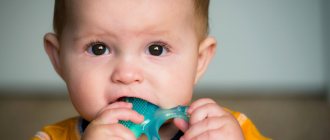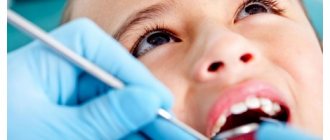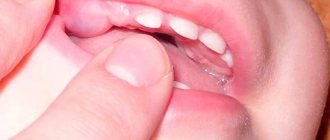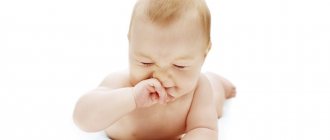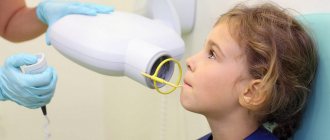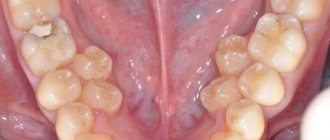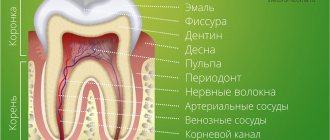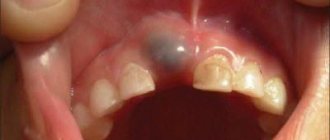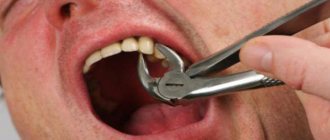The period when a baby's baby teeth erupt is both exciting and difficult for both the child and his parents. Children are often capricious during this period, sleep poorly, cry, and all because the appearance of their first teeth is accompanied by unpleasant sensations. Since the child himself cannot tell his parents about his problem and always reacts the same way to any type of discomfort, it is difficult for mom and dad to differentiate the signs of teething under the child’s behavior.
In this article, especially for young parents, we have collected as much useful information as possible about the eruption of baby and permanent teeth in children, so that you understand what is happening and how to act in this situation to help the baby.
When and what teeth do children erupt?
In fact, the rudiments of baby teeth are formed in children even during the period of embryonic development, and at the moment when they begin to grow and erupt, the rudiments of permanent teeth are already being prepared in the child’s jaw to replace them.
If we talk about the “gold standard”, then the teething scheme looks like this:
- 6-8 months – two central lower incisors.
- At approximately 8 months, the upper central incisors also appear.
- At 8-12 months, the upper lateral incisors appear.
- Around the same time (10-12 months), the lower lateral incisors erupt.
- At 14-20 months, the first chewing teeth appear on the lower and upper jaws (one on each side - 4 in total).
- At 1.5-2 years, the first canines erupt in the upper and lower dentition.
- At the age of 2-3 years, the following chewing teeth appear.
Despite the specified timing, each baby has his own individual teething order. So, some babies show their first teeth at 4.5 months, while others are “delayed” and, on the contrary, grow a little later than the established age. Such features depend on many factors, including gender (usually girls take the lead in teething).
Picture of the appearance of the first molars
Remember, the main thing is that the first teeth erupt before one year. At the same time, do not expect that the process itself will proceed according to the textbook - some children tolerate it easily and almost unnoticeably, others experience intense discomfort.
Sometimes teeth at 3 (three) months begin to manifest themselves very seriously, for example, tissue soreness, refusal to eat and high fever. A runny nose and vomiting are possible as a result of copious discharge.
Regarding the order of eruption and what symptoms appear and how easy or difficult the process itself is, the genetic factor is often of great importance here. Ask how everything went for you, and you can compare the picture of manifestations and draw certain conclusions for the future.
How long does it take for first molars to erupt?
When a child has already lost several teeth, parents have an idea of the duration of the process, but when the very first one appears, it is still difficult to talk about it. The first symptoms begin to appear about a month before actual eruption. For some the duration is a month, for others it is two weeks, everything is very individual.
This can also be used to judge when the baby will have all his milk teeth (20 molars in total). Early teething means that the baby will most likely acquire a whole set of hard formations by the age of two. In such children, new molars appear almost every month and are not accompanied by serious difficulties. For others, this same set is formed only by the age of 3.5, which is also normal.
Formation of milk bite
The process of building a human bite has 5 stages, and all of them occur in childhood.
Each of the five stages is important for the final formation of the entire dental system and dental occlusion:
The first stage is from birth to 6 months (before the appearance of the first teeth).
The second stage is the period of eruption of all baby teeth in a child (6 months - 3 years).
The third stage is the period of jaw growth, preparation for the natural change of milk teeth to permanent ones (3-6 years).
The fourth stage is the time of active growth of the jaws and the eruption of permanent teeth (6-12 years).
The fifth stage is 12-15 years old, when the child’s baby teeth have already changed and all teeth are permanent.
Correct formation of the primary dentition is one of the main conditions for the development of a correct permanent dentition in a child.
Symptoms of baby teeth erupting
Each baby reacts individually to the eruption of baby teeth, however, there are characteristic symptoms by which parents can understand that this is happening:
- heavy salivation;
- redness and swelling of the gums;
- itching
Severe itching and sometimes even painful sensations make the child capricious. He becomes restless, which disrupts his sleep. To somehow relieve the itching, children put toys in their mouths and intensively rub their gums. Children often refuse to eat or eat with less appetite. What does the gum look like when teeth come in? Changes in the condition of the gums are one of the criteria by which parents can differentiate teething. The gums in this place look inflamed - they turn red, swell, and immediately at the site of tooth eruption they become white.
However, the biggest concerns about the child’s condition are cough, runny nose, and fever during teething. Indeed, the appearance of baby teeth in its symptoms can resemble colds, and it is difficult for parents without experience to understand whether the baby is sick or is just teething.
First of all, you need to understand that both fever and cough during teething in children are acceptable reactions. Cough, hoarseness, and runny nose are most often the result of excessive salivation. For the same reason, during teething, babies develop a rash on the chin and around the mouth.
Another frequently asked question from parents is what kind of stool can a child have when teething? During a particularly acute period of teething, babies may have weak stools, which is associated with general irritation of the nervous system and has nothing to do with eating disorders.
However, it must be taken into account that when babies are teething, they are more susceptible than usual to various infections. If unpleasant symptoms (fever, diarrhea, cough) do not go away on their own after 2-3 days, the child should be examined by a doctor.
How long does teething take for babies?
With normal development and growth, baby teeth erupt within a few days (2-8 days), and the most unpleasant symptoms usually appear within about 2 days.
The period of formation of the primary occlusion ends at 2-3 years, and at this moment the baby has 20 primary teeth.
Problems and complications when the first teeth appear
Sore gums, fever, poor appetite and indigestion are, although unpleasant, acceptable symptoms during the eruption of baby teeth.
In some cases, children experience complications:
- long delay - can be either a genetic feature or pathological adentia (if the child has not formed the rudiments of teeth);
- formation of a hematoma (cyst) - in this case, the gum above the growing tooth acquires a dark purple tint, then a lump or hematoma appears in this place, which may be due to both difficult eruption (the tooth cannot cope with the mucous membrane) and other reasons;
- violation of the order of teething;
- aphthous stomatitis - rashes on the mucous membrane in the form of purulent ulcers;
- enamel hypoplasia – occurs in babies under 10 months of age;
- malocclusion - improper closure of teeth, crowding, possible problems with the eruption of permanent teeth in the future.
If your baby experiences “difficult eruption” of primary teeth or you encounter the listed complications, you should definitely consult a pediatrician. If the formation of a primary occlusion is clearly incorrect, consult an orthodontist.
When to see a doctor
If your baby has a fever, is fussy, has diarrhea, or has any other signs of teething, and you are not sure whether your baby's condition is due to teething or one of the common childhood illnesses, your best bet is to see a doctor. The doctor will be able to determine the cause of the illness and, if necessary, recommend treatment.
It is also recommended to consult a pediatrician if your baby experiences severe discomfort when teething. Your doctor may recommend a pain reliever and also rule out other causes of pain and discomfort other than teething. Do not use teething gels to numb your gums as they are not safe.
You should also consult a doctor if your teeth are injured, for example, when a tooth is knocked out or chipped.
What to do when teething: advice for young parents
Now that you know what is happening to your child, you can draw up a rough action plan aimed at making the process of the appearance of the first teeth as easy as possible for the baby.
Tips for moms and dads:
- 1
Stay calm. It’s not easy for a child anyway, and your anxiety and irritation will only negatively affect the baby’s well-being. - 2
Surround your baby with love and tenderness. Remember that small children feel calm and safe only in the arms of loving parents.
- 3
Provide your baby with special gum toys that will help relieve itching and make teething easier.
- 4
Turn on the increased antibacterial protection mode (frequent ventilation, sterilization of toys, pacifiers, etc.), since during this period the child can easily catch an infection.
If your baby's gums are bothering you a lot, you can use a special teething gel. This product has a mild anesthetic effect, relieves itching and pain. Regarding the choice of gel, it is better to consult your pediatrician. He will tell you which drug is suitable for your baby’s age and has a safe composition.
What to do when the temperature rises? Doctors recommend avoiding the use of antipyretic drugs, as the body fights infections by raising the temperature. If hyperthermia is very high, you should consult a pediatrician, he will recommend what medications and in what dosage can be given to the baby. Under no circumstances use folk remedies or medications without first consulting a doctor!
Formation of permanent bite
The development of permanent teeth is a long and complex process. The formation of permanent teeth begins at approximately 3 years of age, when the child’s primary bite is already fully formed.
Preparations for their eruption are ongoing, but changes occur gradually, so most often we don’t even notice them. Meanwhile, the child:
- jaws grow and expand;
- the distance between baby teeth increases (this is important, since permanent teeth are larger and by the time they erupt there should be enough space for them in the dentition).
Timing of eruption of permanent teeth in children
The order of growth of permanent teeth in children is mainly hereditary. In approximately 50% of cases, the molars (sixes) grow first. Second molars appear at 7-8 years of age. Around the same time, the incisors are replaced.
The first permanent tooth appears in children at 6 years of age, and the complete formation of the permanent dentition of the lower and upper jaw is completed at 12-13 years of age. After this, the roots of permanent teeth continue to form and this process ends by the age of 15.
Teething symptoms
Unlike baby teeth, permanent teeth in children erupt almost always painlessly and with virtually no symptoms.
In rare cases, during the teething period the child’s well-being may deteriorate:
- the child gets tired quickly;
- drowsiness appears;
- gums become inflamed;
- salivation increases, a runny nose appears;
- The gums itch where the tooth grows, and when chewing, painful sensations appear.
Problematic eruption of permanent teeth in children
Problems that may arise during the eruption of permanent (molar) teeth:
- 1
Growth retardation – after a baby tooth falls out, the permanent one is in no hurry to appear for 6 months or longer.
- 2
Bite pathology. It may be associated with premature eruption of permanent teeth (if the baby teeth have not yet fallen out), or lack of space on the jaw for normal tooth growth.
- 3
Hyperdentia - permanent teeth grow second row behind the milk teeth. The reason is the strong fixation of the temporary tooth in the socket, as a result of which the permanent tooth “chooses” a more convenient direction for growth.
- 4
Caries and its complications.
Typical problems.
PHOTO: a child’s teeth at 3 years old. Gaps between baby front teeth at age 3 are normal. On the front upper teeth there is caries in the cervical area of the teeth.
There may be a slight rise in body temperature and anxiety in children when their first teeth are cut. This is due to minor inflammation and itching of the gums in the area where teeth are about to erupt. To relieve discomfort, it is recommended to treat the oral cavity with special napkins for oral hygiene, containing special antiseptic and tanning substances.
The most common problem faced by parents aged 12 - 18 months is “bottle” caries, the main cause of which is poor oral hygiene in the child and night feedings. As a result of poor hygiene, a large amount of soft plaque forms on the teeth. Plaque contains a large number of bacteria that produce acid, which “corrodes” the enamel, leading to the formation of caries.
Night feedings at the age of 12 - 18 months create the most favorable conditions for the development of caries, because... At night, saliva production is reduced - the acid of bacteria living in dental plaque is not neutralized.
BREAST-fed children are LESS likely to develop dental caries than bottle-fed children. Breast milk helps saturate the surface of teeth with calcium and phosphate ions. Breast milk contains a large number of immunological protective factors. At the same time, it has been noted that long-term night feeding (both breast and bottle feeding) leads to the development of dental caries, especially in the area of the upper front milk teeth.
PHOTO: A one and a half year old child’s teeth. The front incisors and first molars have erupted. The fang (3rd tooth) is emerging. Often at this age the first injuries occur: the child fell and hit his front upper tooth - the tooth broke.
Against the background of poor hygiene and a weakened immune system, inflammatory diseases of the mucous membrane and stomatitis may develop. Stomatitis in young children is severe, accompanied by general malaise, loss of appetite and increased body temperature.
IT IS VERY IMPORTANT TO START TEACHING YOUR CHILD TO THE NECESSITY OF INDIVIDUAL ORAL HYGIENE FROM THE MOMENT OF THE APPEARANCE OF THE FIRST TEETH. GOOD ORAL HYGIENE IN A CHILD IS THE KEY TO HEALTHY TEETH FROM EARLY CHILDHOOD.
How to help your child: recommendations from Amel Dental doctors
To cope with the discomfort caused by the eruption of permanent teeth, it is enough to massage the child’s gums. If your gums are inflamed, a teething gel will help relieve the inflammation (your dentist will help you choose the right one).
What to do if complications develop?
- 1
Bite problems in children are easier to eliminate than in adults, so if there are defects, you should consult an orthodontist.
- 2
Caries requires immediate treatment, otherwise there is a chance that the child will lose a tooth in childhood.
- 3
If dental growth is delayed, you should immediately see a doctor. One of the main reasons for delayed eruption of permanent teeth in children is immune disorders.
How to relieve symptoms
The basic principle of medicine is to do no harm. Therefore, the first thing you need to do is consult a doctor. You cannot select medications on your own or on the advice of neighbors. And in the pharmacy you can find a lot of ointments and gels with a “cooling” effect and remedies for fever.
Teethers
There are different types of devices. Some of them are used for signs of eruption of the upper teeth, others are suitable for the frontal units or distant molars. The purpose of use is to massage the gums, which alleviates the condition of the little one. You can buy silicone and latex products that are suitable for children as young as 3 months. If mom will massage her gums, she needs a fingertip with a special brush. To help the baby scratch his teeth and play at the same time, special rattles have been created. Teethers for yearlings can be filled with gel or water. They cool the oral cavity well, which “freezes” the pain. The device may vibrate if the baby bites it.
Cream
It is used as a protective agent at the time of increased salivation. This protects the skin of the chin and chest from irritation, especially during a walk in winter.
Vertical position
Parents need to play with their baby more often and distract him from pain. Holding your child upright will reduce pain by reducing blood flow to the head.
Drinking regime
Salivation, especially increased salivation, provokes severe thirst. You need to give your baby more clean water.
Psychological discomfort is compensated by affection, care, and attention. At this time, you should not introduce new foods into the diet, so as not to expose the baby to additional stress.
How to keep children's primary and permanent teeth healthy?
Both baby and molar teeth of a child require careful care. The health of future permanent teeth depends on how healthy the child's baby teeth were. The main concern of parents is quality care, timely treatment and preservation of baby teeth until the time comes for their natural replacement with permanent ones.
What should you do for this?
- Carefully monitor the condition of your baby’s teeth and regularly take him for examinations to the dentist in order to diagnose caries in time.
Prevention of caries is one of the main conditions for the health of a child’s future permanent teeth. You can protect your teeth by ensuring regular high-quality oral hygiene. One of the most effective measures to prevent caries in children is the dental procedure of sealing the fissures of baby teeth.
- Treat caries in a timely manner.
Unfortunately, temporary teeth have very thin enamel and not a very dense structure, so when affected by a carious infection, they are quickly destroyed. With timely diagnosis, caries is treated quickly and without complications - in dentistry, baby teeth are filled with safe materials. Thanks to modern materials and technologies in dentistry, it is even possible to restore baby teeth with severe destruction. In some cases, if the baby tooth could not be saved, and there is still a lot of time left before the permanent teeth erupt, prosthetics of temporary teeth is used.
- Take care of proper nutrition.
Food is an important source of useful vitamins and microelements, so it is important that the child’s diet is varied and balanced.
Both baby and molar teeth of a child require careful care. The habit of brushing teeth and observing the rules of oral hygiene is formed in children from the appearance of their first teeth. Maintaining the health of children's teeth requires very little time and effort, but all this effort will help your child keep his teeth healthy for a long time!
Treatment.
Providing QUALITY dental care to children from the moment the first tooth appears and up to 3 years of age is LIMITED to physiological reasons: mild excitability, restlessness, fear of unknown manipulations in the oral cavity. An attempt to cure teeth by talking to a child or holding him by force in his arms ends with POOR-QUALITY treatment, as a result of which various local complications can develop.
REMEMBER: FORCED TREATMENT WITH CHILDREN RESTRAINT CAUSES IRREPAIRABLE PSYCHOLOGICAL TRAUMA TO THE CHILD!
Like
